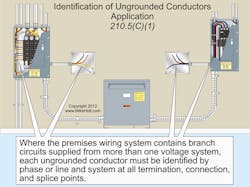Thank you for visiting one of our most popular classic articles. If you’d like to see updated information on this topic, please check out this recently published article, Requirements for the Identification of Branch-Circuit Conductors. |
Q. What are the NEC rules for the identification of circuit conductors?
A. Grounded (neutral) conductors 6 AWG and smaller must be identified by one of the following means [200.6(A)]:
1) By a continuous white outer finish.
2) By a continuous gray outer finish.
3) By three continuous white stripes along its entire length on other than green insulation.
4) Wires that have their outer covering finished to show a white or gray color but have colored tracer threads in the braid identifying the source of manufacture are considered to meet the provisions of this section. The use of white tape, paint, or other methods of identification isn't permitted for grounded conductors 6 AWG or smaller.
6) A single-conductor, sunlight-resistant, outdoor-rated cable used as the grounded conductor in photovoltaic power systems as permitted by 690.31(B) can be identified by distinctive white marking at all terminations.
Grounded (neutral) conductors 4 AWG or larger must be identified by one of the following means [200.6(B)]:
1) A continuous white outer finish along its entire length.
2) A continuous gray outer finish along its entire length.
3) Three continuous white stripes along its length.
4) White or gray tape or markings at the terminations.
If grounded conductors of different voltage systems are installed in the same raceway, cable, or enclosure, each system grounded conductor must be identified by [200.6(D)]:
1) A continuous white or gray outer finish along its entire length.
2) The grounded conductor of the other system must have a different outer covering of continuous white or gray outer finish along its entire length or by an outer covering of white or gray with a readily distinguishable color stripe (other than green) along its entire length.
3) Other identification allowed by 200.6(A) or (B) that distinguishes the grounded conductor from other systems.
A conductor with white insulation can only be used for the ungrounded conductor in circuits of 50V or more as follows [200.6(C)]:
1) Cable assembly. The white conductor within a cable can be used for the ungrounded conductor, if permanently re-identified by marking tape, painting, or other effective means at each location where the conductor is visible to indicate its use as an ungrounded conductor. Identification must encircle the insulation and must be a color other than white, gray, or green.
The white conductor within a cable can be used to supply power to single-pole, 3-way, and 4-way switch loops, as well as travelers for 3-way and 4-way switching if permanently re-identified at each location where the conductor is visible to indicate its use as an ungrounded conductor.
2) Flexible cord. The white conductor within a flexible cord can be used for the ungrounded conductor for connecting an appliance or equipment as permitted by 400.7.
Note: Care should be taken when working on existing systems because a gray insulated conductor may have been used in the past as an ungrounded conductor.
The NEC doesn't permit the use of white or gray conductor insulation for ungrounded conductors in a raceway, even if the conductors are permanently re-identified.
Equipment grounding conductors can be bare, covered, or insulated. Insulated equipment grounding conductors size 6 AWG and smaller must have a continuous outer finish either green or green with one or more yellow stripes [210.5(B), 250.119].
On equipment grounding conductors 4 AWG and larger, insulation can be permanently re-identified with green marking at the time of installation at every point where the conductor is accessible [250.119(A)].
Ungrounded conductors must be identified as follows [210.5(C)]:
• If the premises wiring system contains branch circuits supplied from more than one voltage system, each ungrounded conductor must be identified by phase and system at all termination, connection, and splice points.
• Identification can be by color coding, marking tape, tagging, or other means approved by the authority having jurisdiction.
• The method of identification must be documented in a manner that's readily available or permanently posted at each branch-circuit panelboard.
When a premises has more than one voltage system supplying branch circuits, the ungrounded conductors must be identified by phase and system. This can be done by permanently posting an identification legend that describes the method used, such as color-coded marking tape or color-coded insulation, as shown in the Figure.
Conductors with insulation that's green or green with one or more yellow stripes can't be used for an ungrounded or neutral conductor [250.119].
Although the NEC doesn't require a specific color code for ungrounded conductors, electricians often use the following color system for power and lighting conductor identification:
• 120/240V, single-phase — black, red, and white
• 120/208V, 3-phase — black, red, blue, and white
• 120/240V, 3-phase — black, orange, blue, and white
• 277/480V, 3-phase — brown, orange, yellow, and gray; or, brown, purple, yellow, and gray
About the Author

Mike Holt
Mike Holt is the owner of Mike Holt Enterprises (www.MikeHolt.com), one of the largest electrical publishers in the United States. He earned a master's degree in the Business Administration Program (MBA) from the University of Miami. He earned his reputation as a National Electrical Code (NEC) expert by working his way up through the electrical trade. Formally a construction editor for two different trade publications, Mike started his career as an apprentice electrician and eventually became a master electrician, an electrical inspector, a contractor, and an educator. Mike has taught more than 1,000 classes on 30 different electrical-related subjects — ranging from alarm installations to exam preparation and voltage drop calculations. He continues to produce seminars, videos, books, and online training for the trade as well as contribute monthly Code content to EC&M magazine.

